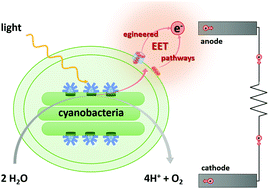A synthetic biology approach to engineering living photovoltaics
Abstract
The ability to electronically interface living cells with electron accepting scaffolds is crucial for the development of next-generation biophotovoltaic technologies. Although recent studies have focused on engineering synthetic interfaces that can maximize electronic communication between the cell and scaffold, the efficiency of such devices is limited by the low conductivity of the cell membrane. This review provides a materials science perspective on applying a complementary, synthetic biology approach to engineering membrane–electrode interfaces. It focuses on the technical challenges behind the introduction of foreign extracellular electron transfer pathways in bacterial host cells and past and future efforts to engineer photosynthetic organisms with artificial electron-export capabilities for biophotovoltaic applications. The article highlights advances in engineering protein-based, electron-exporting conduits in a model host organism, E. coli, before reviewing state-of-the-art biophotovoltaic technologies that use both unmodified and bioengineered photosynthetic bacteria with improved electron transport. A thermodynamic analysis is used to propose an energetically feasible pathway for extracellular electron transport in engineered cyanobacteria and identify metabolic bottlenecks amenable to protein engineering techniques. Based on this analysis, an engineered photosynthetic organism expressing a foreign, protein-based electron conduit yields a maximum theoretical solar conversion efficiency of 6–10% without accounting for additional bioengineering optimizations for light-harvesting.



 Please wait while we load your content...
Please wait while we load your content...